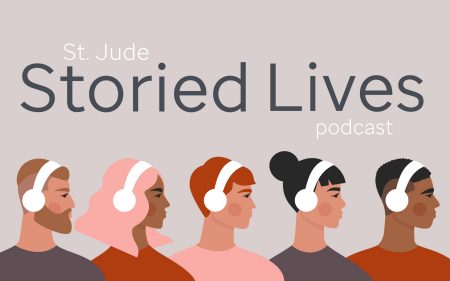
Life-changing experience at St. Jude shaped Coraliz’s career path
This medical laboratory scientist finds inspiration and purpose after cancer treatment.

July 07, 2025 • 5 min

Español | English
Every result can change a life.

That’s why Coraliz gives her all in her work as a medical laboratory scientist.
She makes sure every analysis is accurate and meaningful.
Where others see just another lab sample, she sees a real person — with a name and a story. Where others see a diagnosis, she sees what it could mean for that person’s future and for the people who love them most.
She analyzes everything from blood to bacteria. In her job at a clinical lab in Mississippi — where she works with both adult and pediatric samples — there is no room for distraction or error.
“It can be a very stressful job, but I try to get the results as quickly and accurately as possible, to make sure that person ends up getting the medical care they truly need,” she said.
It wasn’t until high school that she discovered her passion for laboratory science.
“I've always had an interest in science and research. And I was like, ‘This field is perfect for me because I want to be involved in patient care, but I kind of want to work behind the scenes.’”
Coraliz has learned to combine her scientific training with a kind of compassion that can’t be taught in school — it comes from her own experience as a patient at St. Jude Children’s Research Hospital®.

It all began when she was 10 years old after she was kicked in the leg during a physical education class. Coraliz was diagnosed with osteosarcoma, a bone cancer most seen in children and young adults. It is the most common childhood bone tumor. Soon after, she was referred to St. Jude for treatment.
"My leg started swelling, almost the size of a baseball," Coraliz said.
It was a confusing and frightening time — filled with questions and uncertainty.
She still remembers the first night at St. Jude like it was yesterday. It was late — well past midnight — when she arrived, exhausted and scared. Fear had settled deep in her chest, heavy and unshakable. But the moment she walked through those doors, something softened. The staff didn’t just greet her — they embraced her, in spirit if not in arms. Their kindness cut through the uncertainty, and for the first time in a long time, she felt like maybe, just maybe, she wasn’t alone in this.
"I had never seen a hospital so colorful and full of art! The entire staff, the patients, the families … everyone was so kind and welcoming."
She spent nine months undergoing chemotherapy and had surgery to amputate one of her legs. Her parents said that the staff took the time to explain every part of the treatment process with care and compassion, helping them prepare both mentally and emotionally.

“We never felt alone; there was always someone there to guide us through each step. What meant the most was that they didn’t just care for our daughter; they cared for our whole family. The entire staff treated us with kindness, always offering a smile and a helping hand. That kind of support made all the difference,” Lesbia, her mom, said.
Lesbia remained by her daughter’s side throughout, while her father, Omar, and older brother, Joshua, visited frequently from Alabama, where the family had been living at the time of her treatment.
"I remember that at St. Jude, if your lab results were good, you could go home for a week to see your family. Those results meant everything. That’s why I work so hard."
In January 2012, doctors confirmed there was no longer any evidence of cancer.
"It was a life-changing experience in the best way. It made me who I am, and I’m grateful for that."
‘Always learning something new’
Her experience at St. Jude shifted how she sees the world.

"I always like to say that I'm a work in progress. I'm always learning something new every day. And I feel like I handle stress differently, especially working in a very stressful environment in healthcare."
Coraliz doesn’t just turn samples into meaningful results. When she’s off the clock, she paints — turning colors into figures of comfort and hope. She especially loves working with acrylics, drawn to their boldness and versatility. Her favorite subjects? Flowers and landscapes — scenes that remind her of peace, growth and the quiet strength it takes to keep moving forward.
“I still love to draw, paint, anything that involves arts and crafts. I still love doing that today. It's one of my best ways to relieve stress and express my creativity.”
She credits her love of art to her father, and says it dates to her days as a young girl. That’s when she and her father would spend countless hours side by side creating art.
“When I reflect on my relationship with my daughter, I don’t just consider our conversations or lessons; I think about the quiet moments we share (while painting). This artistic expression has become our bond,” Omar said. “In those moments, we understand that art isn’t just a passion for us, it’s a space where we share ideas and, also, cherished memories.”
Coraliz said art was an important therapeutic tool during treatment: “It just helped me cope with what was going on.”

“This art is about overcoming obstacles. The mountains symbolize that there’s always light at the end of the tunnel — a reminder that tomorrow is a new day, and things do get better.”
At St. Jude, she not only found encouragement to explore her artistic side, but she was also invited to share her work. Her pieces have appeared on murals, T-shirts and even on the iconic Times Square Ball in 2013. One of her colored pencil drawings — a rose design — was transformed into a special piece that was etched into a crystal panel for the Times Square New Year’s Eve Ball.
“It was an unforgettable moment, one of the most meaningful experiences of my life. Seeing my artwork there is something I’ll never forget," she said, her voice filled with emotion.
Inspiring by example
Most osteosarcoma patients who have amputation or limb-sparing surgery do well over time. They report good physical function and quality of life.
In Coraliz’s case, doctors had to amputate her left leg. Later, she underwent physical therapy to help regain strength and mobility in her right leg. Still, it was something she felt insecure about, especially in school.
“But now it's become my thing. And I want to show other people with disabilities that if I can do it, they can do it as well,” she said.

“This piece represents healing hands everywhere — the support we receive from friends, family and those who care.”
“I always say that my prosthetic leg is my trophy for beating cancer.”
She remembers drawing strength from one of her nurses at St. Jude.
“She only had one hand and did everything — from changing IV lines to drawing blood. No one even noticed because she did it perfectly,” Coraliz said.
It’s been 13 years since her treatment, and Coraliz now returns to St. Jude every five years as part of the St. Jude LIFE study, a groundbreaking research program that helps researchers learn about the long-term health of childhood cancer survivors.
She says every visit still feels like coming home. Later in her career, she hopes to return — not as a patient, but as part of the team.
“Coming back to St. Jude as a professional isn’t just a dream; it would be a way to close the circle because I want to be part of the amazing work they do,” she said.
Unlike most hospitals, St. Jude relies on donations to provide care. To understand why that support matters, Coraliz says it best: "St. Jude gave me more than just treatment. It gave me direction, friendships, family and my future. It gave me my life back."




















